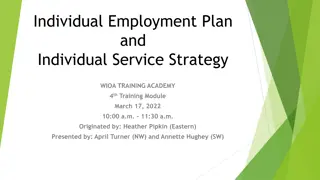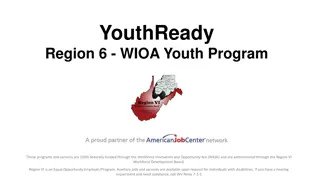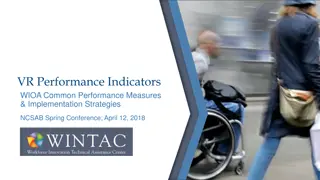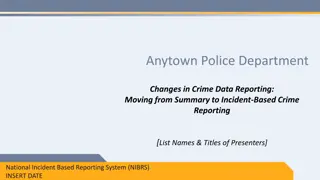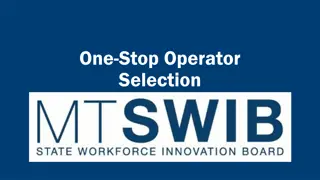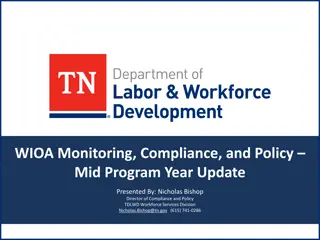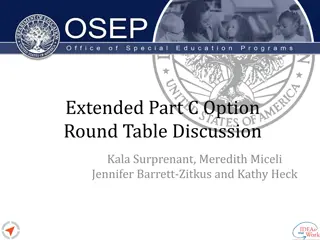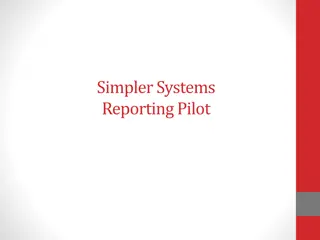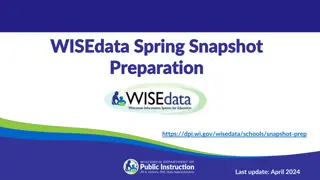WIOA Performance Data Collection and Reporting Overview
Requirements for reporting under the WIOA program, including data collection, negotiations, and outcomes reporting. Details on the reporting periods, reporting entities, core programs, partners, and the individuals included in the Participant Individual Record Layout (PIRL) reports.
Download Presentation

Please find below an Image/Link to download the presentation.
The content on the website is provided AS IS for your information and personal use only. It may not be sold, licensed, or shared on other websites without obtaining consent from the author. Download presentation by click this link. If you encounter any issues during the download, it is possible that the publisher has removed the file from their server.
E N D
Presentation Transcript
WIOA Performance WIOA Performance Data Collection Data Collection, , Reporting, Negotiations, Reporting, Negotiations, and Outcomes and Outcomes JULY 5TH, 2022
WIOA Reporting Requirements DOL requires each grantee to submit a Participant Individual Record Layout (PIRL) report, which contains record-level data on participants served, both quarterly and annually, for core programs. Report Type Report Type Report Period Report Period Quarter Quarter Due Dates Due Dates Quarterly January 1-March 31 3 May 15 States are required to include 2.5 years/10 quarters of reportable individual, participant, and exiter data in each PIRL report. Quarterly April 1-June 30 4 Aug 15 Quarterly July 1 -September 30 1 Nov 15 Quarterly October 1 -December 31 2 Feb 15 Annual July 1 - June 30 All Oct 1
WIOA Core Programs and Partners What are the WIOA Core programs and which division is responsible for reporting? What are the WIOA Core programs and which division is responsible for reporting? Administered by / Responsible Reporting Administered by / Responsible Reporting Entity Entity Title Title Program Name Program Name Title I WIOA Adult, Dislocated Worker and Youth MT Department of Labor Adult Education and Family Literacy Act (AEFLA) Title II MT Office of Public Instruction Title III Wagner-Peyser MT Department of Labor Title IV Vocational Rehabilitation MT Department of Health and Human Services *The following presentation is applicable to programs administered & reported on by MT Dept. of Labor only.
Who is included in the PIRL? MT DOL is required to report on individuals served under WIOA titles I and III programs, as well as other employment and training programs administered by USDOL including: DWG (Dislocated Worker Grants) Cohort Cohort Description Description JVSG (Jobs for Veterans State Grants) Individuals who, during the reporting period, have provided identifying information, only used the self-service system, or only received information-only services or activities. TAA (Trade Adjustment Assistance) Reportable Individuals Participants who started participation before or during the period and either have not exited or exited after the start of the period. Within each quarterly and annual PIRL report, grantees are reporting out on multiple cohorts of the individuals they serve. The table to the right identifies the basic cohort definitions that apply across workforce development programs funded by DOL. Current Participants Exiters Participants who have an exit date during the previous quarter.
What data is collected in the PIRL? The USDOL PIRL (ETA-9172) schema contains over 400 data elements that grantees are required to collect information on for individuals included in PIRL reporting. The data elements consist of the following: Demographic information (e.g., date of birth, ethnicity/race) Program engagement (e.g., date of program entry, date of program exit, program type) Service details (e.g., most recent date received basic career services, date first staff- assisted service) Outcome data (e.g., employed in 2nd quarter after exit, employed in 4th quarter after exit quarter, wages 2nd quarter after exit quarter) Referral details (e.g., most recent date referred to employment, referred to Jobs for Veterans State Grants Services) Training details (e.g., date entered training, type of training service, training completed) Excerpt from DOL Excerpt from DOL- -only PIRL (ETA only PIRL (ETA- -9172) schema 9172) schema
WIOA Performance Indicators Why is performance important? Why is performance important? The public workforce development system provides resources, services, and tools to support individuals and businesses in developing and maintaining a workforce to support a thriving economy throughout the nation. Given the critical importance of this system, its performance at the local, state, and federal levels is vitally important. Consistent, accurate performance reporting allows the workforce system to assess its effectiveness, make data-informed improvements, be accountable to taxpayers, and, ultimately, support vibrant communities, businesses, and families throughout the nation. How many performance indicators are there? How many performance indicators are there? There are six primary indicators of performance under WIOA; five that look at outcomes for job seekers and one that looks at outcomes of services to employers. How often is performance assessed? How often is performance assessed? The performance measures are calculated for each quarterly and annual PIRL report submitted. However, only the annual report s scores can determine whether a state is passing/failing for the program year. What is considered a program year ? What is considered a program year ? A program year begins on July 1st and ends on June 30th. ***Some WIOA Youth performance indicators use a unique calculation method that is specific to the population being served in the program. Differences are noted in the following slides.
What is being measured? What is being measured? Here we are measuring the employment outcomes of Adult, Dislocated Worker and Employment Service (Wagner-Peyser) exiters. Successful outcomes are all participants who exited during the reporting period who were in unsubsidized employment during the second quarter after exit from the program. For Youth participants, successful outcomes also include participants who were in training or Education in the 2nd quarter after program exit. Employment Rate 2nd Quarter After Exit Why is it being measured? Why is it being measured? WIOA Title I programs are intended to prepare individuals with the knowledge and skills necessary to gain meaningful employment. The Employment Rate 2nd quarter after exit measure captures an individual s initial employment after exit from a program. The measure racks the ability of program participants to be in unsubsidized employment at any point during the 2nd post exit quarter. Note that it is not intended to provide indication of the level of employment during these periods such as whether it was full time or part time or continuous throughout the quarter or year.
What is being measured? What is being measured? Here we are measuring the employment outcomes of Adult, Dislocated Worker and Employment Service (Wagner-Peyser) exiters. Successful outcomes are all participants who exited during the reporting period who were in unsubsidized employment during the fourth quarter after exit from the program. For Youth participants, successful outcomes also include participants who were in training or Education in the 4th quarter after program exit. Employment Rate 4th Quarter After Exit Why is it being measured? Why is it being measured? WIOA Title I programs are intended to prepare individuals with the knowledge and skills necessary to gain meaningful employment. The Employment Rate 4th quarter after exit measure captures an individual s subsequent employment retention after exit from a program. The measure racks the ability of program participants to be in unsubsidized employment at any point during the 4th post-exit quarter. Note that it is not intended to provide indication of the level of employment during these periods such as whether it was full time or part time or continuous throughout the quarter or year.
What is being measured? What is being measured? Here we are measuring the earnings of program exiters. Successful outcomes are all participants who exited during the reporting period with earnings. Median Earnings 2nd Quarter After Exit Why is it being measured? Why is it being measured? The Median Earnings 2nd quarter after exit measure captures the median earnings of individuals with reported wages during the 2nd quarter after exit. For all participants who are employed at anytime during 2nd quarter after exit, all wages are listed in order from lowest to highest. The value in the middle of this list is the median earnings calculation. Only those wages received during the 2nd quarter after exit are included in the list to calculate the median wage.
What is being measured? What is being measured? Here we are measuring the credentials that program participants in education or training have earned. Successful outcomes are participants in education or training who obtain a recognized postsecondary credential or a secondary school diploma, or its recognized equivalent, during the program or within one year after exit. Credential Attainment Why is it being measured? Why is it being measured? Credentials may contribute to improved employment retention and an increase in earnings. They also play an important role in developing a skilled workforce that meets the needs of business. They should attest to an individual s skills and competencies and serve as an important indicator that businesses can select from a pool of qualified individuals.
Credential Attainment Additional Info Types of Acceptable Credentials Secondary School diploma or recognized equivalent Associates degree Bachelors degree Occupational licensure Occupational certificate, including Registered Apprenticeship and Career and Technical Education educational certificates Occupational certification Other recognized certificates of industry/occupational skills completion sufficient to qualify for entry-level or advancement in employment. *Credential Attainment Rate specifications for WIOA Youth: All ISY (In-School Youth) are included Not all OSY (Out of School Youth) are included. Only those in the following types of training are included: Bachelors degree, Occupational skills training program, Secondary education (at or above 9th grade level), Postsecondary education, Adult Education (at or above 9th grade level), Youthbuild, Job Corps
What is being measured? What is being measured? Here we are measuring the progress of program participants in training or education. Successful outcomes are: of the participants currently enrolled in an education or training program leading to a recognized postsecondary credential, the unique count of the most recent date on which participants achieved Measurable Skill Gains in the reporting period. Measurable Skill Gains Why is it being measured? Why is it being measured? The measure is intended to track and measure important progressions and achievements made by WIOA participants, who are enrolled in training or education, through pathways and towards various goals of their individual programs. Gains measure progress made through different services based on program purposes and participant needs and can help fulfill the vision for a workforce system that serves a diverse set of individuals.
Measurable Skill Gains Additional Info Types of Measurable Skill Gains EFL (Education Functioning Level): Documented achievement of at least one educational functioning level of a participant who is receiving instruction below the postsecondary education level; Secondary School Diploma: Documented attainment of a secondary school diploma or its recognized equivalent; Secondary or postsecondary transcript or report card: Documentation for a sufficient number of credit hours that shows a participant is meeting the state unit s academic standards; Training Milestone: Satisfactory or better progress report towards established milestones, such as completion of OJT or completion of one year of an apprenticeship program or similar milestones, from an employer or training provider who is providing training; or Skills Progression: Successful passage of an exam that is required for a particular occupation or progress in attaining technical or occupational skills as evidenced by trade-related benchmarks such as knowledge-based exams. *Measurable Skill Gains Rate specifications for WIOA Youth: All ISY (In-School Youth) are included Not all OSY (Out of School Youth) are included. Only those in the following types of training are included: Bachelors degree, Occupational skills training program, Secondary education (at or above 9th grade level), Postsecondary education, Adult Education (at or above 9th grade level), Youthbuild, Job Corps
Effectiveness in Serving Employers What is being measured? What is being measured? This indicator is a new approach for measuring performance under WIOA and looks at outcomes of services to employers. The six WIOA core programs administered by DOL and ED have implemented a pilot program during which grantees must select two of three approaches to report data that the Departments will use to assess a permanent indicator. Which measures has MT DOL chosen to report on? Which measures has MT DOL chosen to report on? MT DOL has chosen to report on all three Federal measures for the Effectiveness in Serving Employers performance indicator. Measure Measure Description Description Calculation Calculation The percentage of participants who are employed with the same employer in the 2nd and 4th quarters after exiting the program. Retention with the same employer Addresses the programs efforts to provide employers with skilled workers. Addresses the programs efforts to provide quality engagement and services to employers and sectors and establish productive relationships with employers and sectors over extended periods of time. The percentage of repeat employers using services within the three previous program years. Repeat Business Customers Addresses the programs efforts to provide quality engagement and services to all employers and sectors within a State and local economy. The percentage of employers who are using program services out of all employers represented in the state. Employer Penetration Rate
WIOA Performance Level Negotiations For the DOL-funded WIOA core programs, states must reach agreement with DOL on levels of performance for each of the primary indicators of performance (WIOA Section 116(b)(3)). These are referred to as negotiated levels of performance. Negotiations shall take place in two-year intervals In negotiating levels of performance, the states and DOL must apply the following factors: 1. Comparison with negotiated level of performance established for other states 2. Adjustments using DOL s statistical adjustment model 3. Promotion of continuous improvement in performance accountability measures 4. Assistance in meeting long-term performance Government Performance and Results Act (GPRA) goals
MT Negotiated Levels of Performance PY 2022 & 2023
Assessing a States Performance At the end of each program year, DOL adjusts the negotiated levels of performance to reflect actual characteristics of participants served and the actual economic conditions experienced using a statistical adjustment model. These are referred to as adjusted levels of performance. Three criteria of performance: 1. The overall program score: the average of all individual indicators within a program. States have a performance failure if an overall score is below 90%. 2. The overall State indicator score: the average of a particular individual indicator score across programs. States have a performance failure if an overall score is below 90%. 3. The individual indicator score: The scores are calculated by dividing the actual level of performance by the adjusted level of performance. States have a performance failure if an overall score is below 50%. A state s failure to report or failure to meet adjusted levels of performance can lead to sanctions. Once adjusted negotiated levels of performance have been calculated, performance is determined using three criteria.
Montanas Performance Results for PY 20 Some things to note about the performance assessment from USDOL: The Department of Labor evaluated the statistical adjustment model s effectiveness in accounting for the impacts of the COVID-19 pandemic, and found that the model sufficiently adjusted for these impacts with respect to the measures being assessed here. The model did however consistently overestimate Employment Rate 2nd Quarter after Exit results, indicating there was variation in the state results that was not represented in the model. The Department of Labor will continue to refine the model with additional data and improved methodologies and work with the Department of Education to ensure fair and objective performance assessments. The Departments of Labor and Education issued a notice indicating which primary indicators of performance will be assessed for PY 2020 and PY 2021. The Department of Labor published this as Training and Employment Notice (TEN) 14-21 [wdr.doleta.gov]. For PY 2020, the only performance indicators being formally assessed are Employment Rate 2nd Quarter after Exit and Median Earnings 2nd Quarter after Exit and the only programs being formally assessed are the WIOA title I (WIOA Adult, WIOA Dislocated Worker, and WIOA Youth) and title III (Wagner-Peyser Act Employment Service) programs
Key Terms & Definitions The negotiated level of performance is the agreed upon target level of performance for PY 2020 prior to the start of PY 2020. The adjusted level of performance is the result of re-calculating the negotiated level of performance once PY 2020 ends. It is calculated using model estimates, data on actual program participants in PY 2020, and data on actual economic conditions in which the participants were served. The adjustment factor is the total amount that the original negotiated level was adjusted. The actual level of performance shows the actual reported performance results for the indicator and includes the individual indicator score (i.e., the actual level divided by the adjusted level).
Montanas Performance Results for PY 20 The figure below shows the individual indicator scores for each program. The scores are calculated by dividing the actual level of performance by the adjusted level of performance (the values used in the calculation are shown in the box). A failure occurs if an individual indicator score is below 50%.
WIOA Adult Program Year 2020 Employment Rate Q2 Passing Median Earnings Q2 Passing Adjustment Factor of - $304 applied to Negotiated Level ($6,159) for PY 20. Adjustment Factor of +5.4% applied to Negotiated Level (71%) for PY 20. Adjusted Level: $5,855 Adjusted Level: 76.4% Actual Level of performance: $6,815 Actual Level of performance: 74.8% Indicator Score: 116.4% ($6,815 / $5,855) 116.4% Indicator Score: 97.8% (74.8% / 76.4%) 97.8%
WIOA Dislocated Worker Program Year 2020 Employment Rate Q2 Passing Median Earnings Q2 Passing Adjustment Factor of +4.6% applied to Negotiated Level (71%) for PY 20. Adjustment Factor of -$436 applied to Negotiated Level ($7,000) for PY 20. Adjusted Level: 75.6% Adjusted Level: $6,564 Actual Level of performance: 84.3% Actual Level of performance: $9,393 Indicator Score: 111.5% 111.5% (84.3% / 75.6%) Indicator Score: 143% ($6,564 / $9,393) 143%
WIOA Youth Program Year 2020 Median Earnings Q2 Passing Employment Rate Q2 Passing Adjustment Factor of -$99.80 applied to Negotiated Level ($7,000) for PY 20. Adjustment Factor of -1.5% applied to Negotiated Level (60%) for PY 20. Adjusted Level: $3,200 Adjusted Level:58.5 % Actual Level of performance: 55.1% Actual Level of performance: $3,988 Indicator Score: 128.6% 128.6% ($3,988 / $3,100) Indicator Score: 94.1% (55.1% / 58.5%) 94.1%
WIOA Wagner Peyser Program Year 2020 Median Earnings Q2 Passing Employment Rate Q2 Passing Adjustment Factor of +$1,001 applied to Negotiated Level ($5,600) for PY 20. Adjustment Factor of +11% applied to Negotiated Level (67%) for PY 20. Adjusted Level: $6,601 Adjusted Level:78% Actual Level of performance: 62.9% Actual Level of performance: $6,264 Indicator Score: 94.8% 94.8% ($6,264 / $6,601) Indicator Score: 80.5% (62.9% / 78.0%) 80.5%
Performance Resources TEGL No. 10-16, Change 1, Performance Accountability Guidance for Workforce Innovation and Opportunity Act (WIOA) Title I, Title II, Title III, and Title IV Core Programs (August 23,2017) TEGL No. 14-18, Aligning Performance Accountability Reporting, Definitions, and Policies Across Workforce Employment and Training Programs Administered by the U.S. Department of Labor (DOL) (March 25, 2019) PIRL Reporting Online Resource Revised E-Learning Series on Performance Indicators



